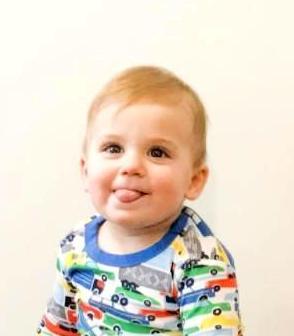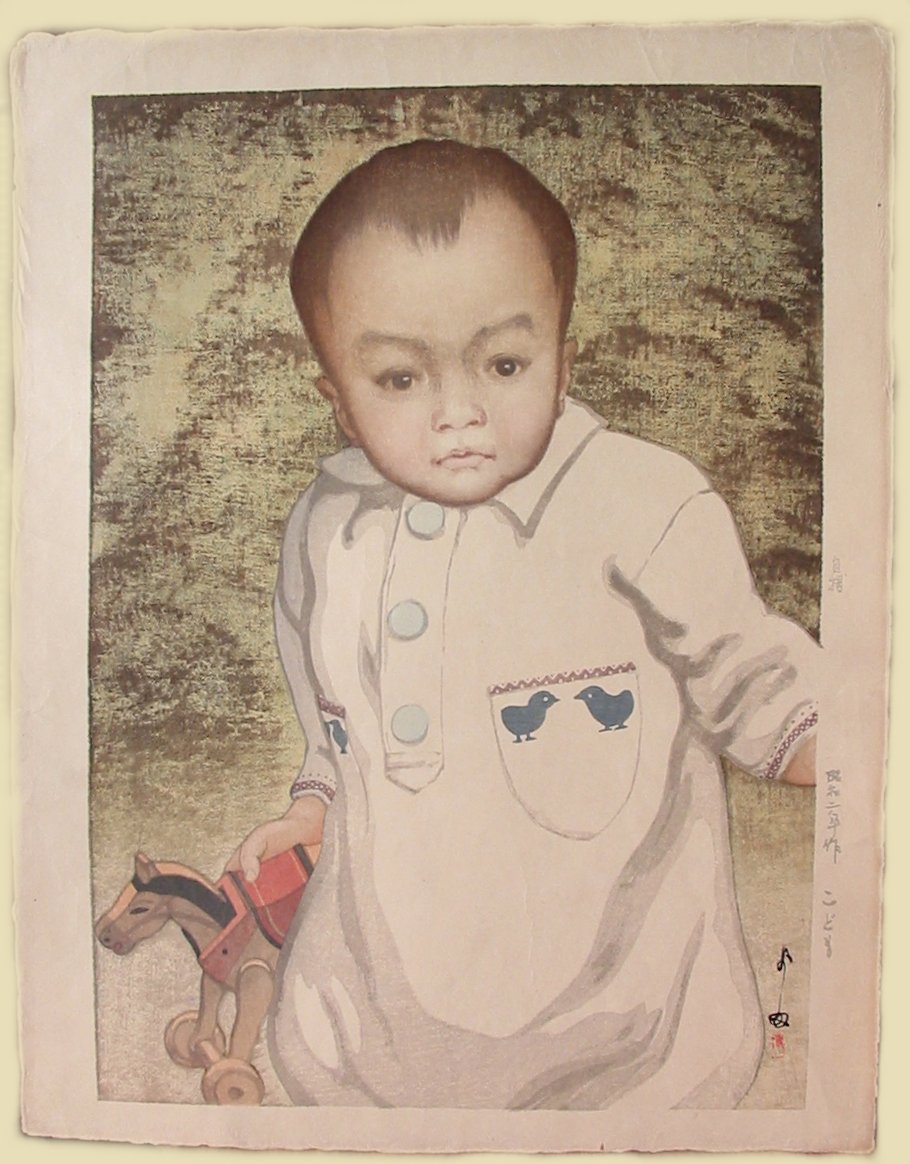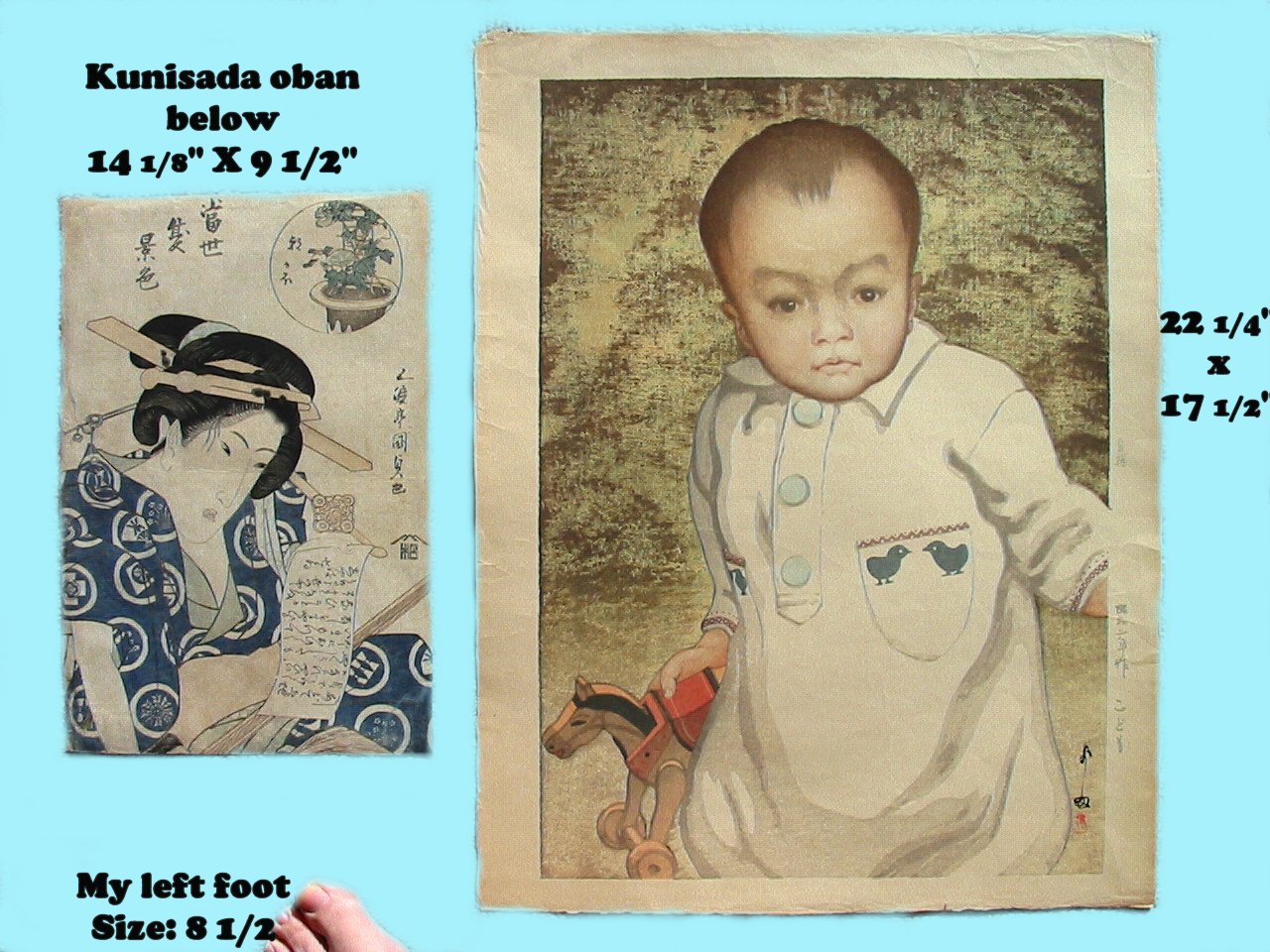
JAPANESE PRINTS
A MILLION QUESTIONS
TWO MILLION MYSTERIES
Ukiyo-e Prints浮世絵版画 |
|
formerly Port Townsend, Washington now Kansas City, Missouri |
|
HIROSHI YOSHIDA |
|
吉田博 |
|
1876-1950 |
|
"PORTRAIT OF A BOY" "KODOMO" こども |
|
Size: 22 1/4" x 17 1/2" Large oversized prints are referred to as bai oban. |
|
Date: 1927 Shōwa Ni Nen Saku 昭和二年(Saku) Shōwa 2 |
|
Edition Size: 80 At the back of Hiroshi Yoshida's book Japanese Woodblock Printing (p. 175) the artist notes that there were ten blocks used and that there were "60 impressions for the face; printing what is not in the block; dry brush." |
|
Top Seal on Right: Jizuri 自摺 Self-printed |
|
Block Carver: Mayeda |
|
Condition: Somewhat toned, but otherwise in good condition. |
|
Illustrated in:
and
in Artibus Asiae, 1951, vol. 14. Blair wrote: "At one time Mr. Yoshida became interested in portraiture and the three-dimensional representation of facial and body contours and fleshtones. Outstanding among the few figure prints is the portrait of his younger son, Hodaka, as a child, entitled simply Child (Kodomo). It is an interesting example of these experiments, but it required the abnormal total of eighty superimposed printings, of which sixty were used on the head alone. This was part of a specialized experiment in the year 1926 which Mr. Yoshida did not continue further." |
|
SOLD! |

|
There are other copies of this print in the collection of the Boston Museum of Fine Arts ,
and
|

|
|
|
There is a short reference to the printed background technique of this print in Yoshida's own Japanese Woodblock Printing (1939, p. 97):
"Other kinds of baren may be made according to one's need. Once I used one made with cardboard for a pad, not for rubbing but merely for tapping the paper on the back to get a certain effect for the background of my print, 'Portrait of a Boy'".
This statements makes it even clearer that each printed example of this image will vary considerably as regards the backgrounds. Unlike the uniformity so often sought in European prints, such as those of Picasso or Miro or a myriad of others, each of these has its own unique personality. Naturally any print involving special handwork, i.e., all traditional Japanese woodblock prints, must differ one from the other even though it is sometimes incredibly difficult to spot. That speaks to the skill of the specialists who earned their keep by pressing baren to paper.
In discussion of the special technique of goma-zuri (ごま摺り) Yoshida notes that "Goma means sesame [胡麻] and suggests black particles on white. It is obtained by a soft rubbing of the baren. This is better produced while the surface of the paper is yet fresh. In getting the goma effect, paste is not absolutely necessary, though it may be needed to prevent the paper from slipping. A baren made of a four-strand cord, or a worn-out baren, or a paper-cord baren - the weakest kind of a baren - is the best for this purpose. An extravagant use of pigment is required to produce a certain goma effect, and a scanty use of it produces another effect. Use according to the need. Do not place too much pressure on the baren." (p. 111)
Later he adds: "There may be large or small goma. These can be produced by the kind of baren used and the amount of strength applied in printing. The coarsest kind of goma may be obtained by merely dropping the paper on the block. Slightly finer effects may be obtained by lightly pressing the paper with a flat baren. Various grades of goma may be mixed in order to produce an interesting background, as that in my print entitled 'Portrait of a Boy'." (pp. 111-12)
*****
|
|
I have always been troubled by my failure to grasp the sense of scale when looking at isolated images in books or on-line. There is a wonderful little portrait head by Madrazo or Fortuny in the Walters, I believe. In a full page reproduction in a book it looks absolutely monumental. But in reality it is miniscule --- just a few inches by a few inches. I kid you not. I had known the print shown above for years from the catalogue on Yoshida. In the catalogue with its smallish, but decent, reproduction the head of the baby looked like it was at the least a lithographic element or at most a photogravure insert. Too realistic to be a woodcut. But as you can see from the large image on this page it is indeed a woodcut. I jumped at the opportunity to purchase one of these masterpieces. What I was not prepared for was its size. Oh yeah, I could read the dimensions and I could make a template, but it is never the same thing until you have the actual item before you. (I must lack the gene of true extrapolation.) When you go camping and you read that a mountain is 14, 237 feet high and even if you have seen photos of it it just isn't they same until you sweat and ache getting to the top or collapse that night into your sleeping bag almost on the edge of delirium. So it is with oversized prints --- at least for me. Usually one finds an image being photographed with something familiar next to it like a dime to give the viewer a sense of scale. Just look at some of the examples on e-Bay. A 7' vase just isn't the same until you have a normal sized person posing beside it. That is why I have added the image below --- so you will believe me and get a little bit of the thrill I do. (Oh yeah, and maybe sometimes I wear a size 9 extra wide.) |
|
|


 HOME
HOME